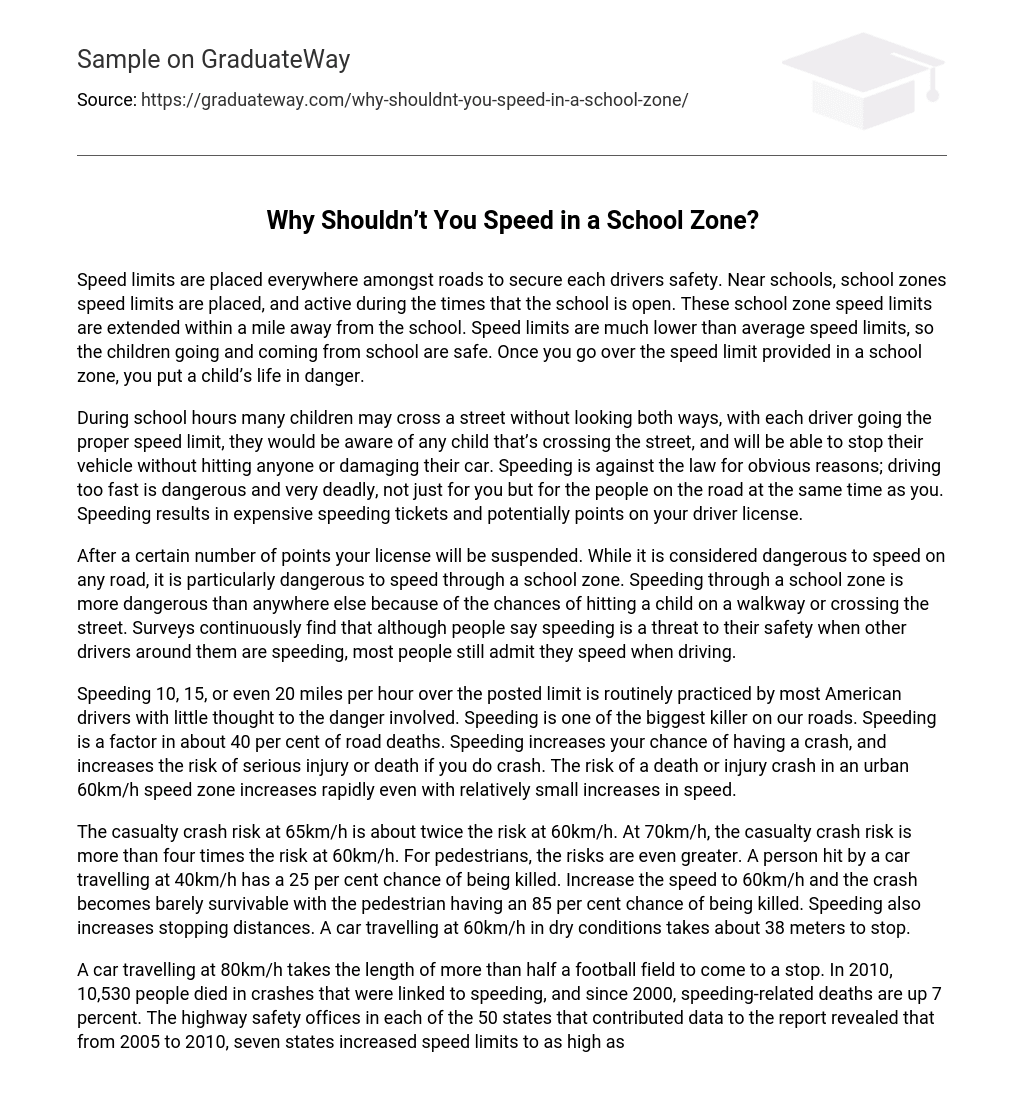Speed limits are placed everywhere amongst roads to secure each drivers safety. Near schools, school zones speed limits are placed, and active during the times that the school is open. These school zone speed limits are extended within a mile away from the school. Speed limits are much lower than average speed limits, so the children going and coming from school are safe. Once you go over the speed limit provided in a school zone, you put a child’s life in danger.
During school hours many children may cross a street without looking both ways, with each driver going the proper speed limit, they would be aware of any child that’s crossing the street, and will be able to stop their vehicle without hitting anyone or damaging their car. Speeding is against the law for obvious reasons; driving too fast is dangerous and very deadly, not just for you but for the people on the road at the same time as you. Speeding results in expensive speeding tickets and potentially points on your driver license.
After a certain number of points your license will be suspended. While it is considered dangerous to speed on any road, it is particularly dangerous to speed through a school zone. Speeding through a school zone is more dangerous than anywhere else because of the chances of hitting a child on a walkway or crossing the street. Surveys continuously find that although people say speeding is a threat to their safety when other drivers around them are speeding, most people still admit they speed when driving.
Speeding 10, 15, or even 20 miles per hour over the posted limit is routinely practiced by most American drivers with little thought to the danger involved. Speeding is one of the biggest killer on our roads. Speeding is a factor in about 40 per cent of road deaths. Speeding increases your chance of having a crash, and increases the risk of serious injury or death if you do crash. The risk of a death or injury crash in an urban 60km/h speed zone increases rapidly even with relatively small increases in speed.
The casualty crash risk at 65km/h is about twice the risk at 60km/h. At 70km/h, the casualty crash risk is more than four times the risk at 60km/h. For pedestrians, the risks are even greater. A person hit by a car travelling at 40km/h has a 25 per cent chance of being killed. Increase the speed to 60km/h and the crash becomes barely survivable with the pedestrian having an 85 per cent chance of being killed. Speeding also increases stopping distances. A car travelling at 60km/h in dry conditions takes about 38 meters to stop.
A car travelling at 80km/h takes the length of more than half a football field to come to a stop. In 2010, 10,530 people died in crashes that were linked to speeding, and since 2000, speeding-related deaths are up 7 percent. The highway safety offices in each of the 50 states that contributed data to the report revealed that from 2005 to 2010, seven states increased speed limits to as high as 85 mph, while only two states raised fines for speeders and just one state, which is Indiana, passed an aggressive driver law.
According to reports, “Few advocates exist for speed reduction; speeding is a behavior that many people engage in routinely. ” In 1974, the United States government put a maximum speed limit of 55 miles per hour into action on roads across the nation. This was mostly to offset the increasing costs of oil, but research also found that it made roads much safer. The amount of car accidents decreased, as well as the amount of fatalities caused by car accidents. It makes sense that the severity of a car crash is directly impacted by how fast the vehicles are moving.
The slower that a vehicle is moving, the less momentum it has, which decreases the impact. One of the most obvious consequences of driving fast is a decrease of time to react to an emergency situation. One of the most obvious consequences of driving fast is a decrease of time to react to an emergency situation. There are three major components that make up what is known as your ‘reaction time’. The first component is mental processing. This is the time it takes your brain to process your sensory input, and then decide on a course of action.
Mental processing is also comprised of four sub-components; Sensation is the time it takes to detect sensory input, perception/recognition is the time needed to recognize the sensation, situational awareness is the time needed to recognize and interpret the situation, and response selection is the time necessary to decide how you are going to respond. The second component is movement. This is the time it takes your body to put your mental decision into physical action, such as taking your foot off of the gas pedal and then engaging the brakes.





